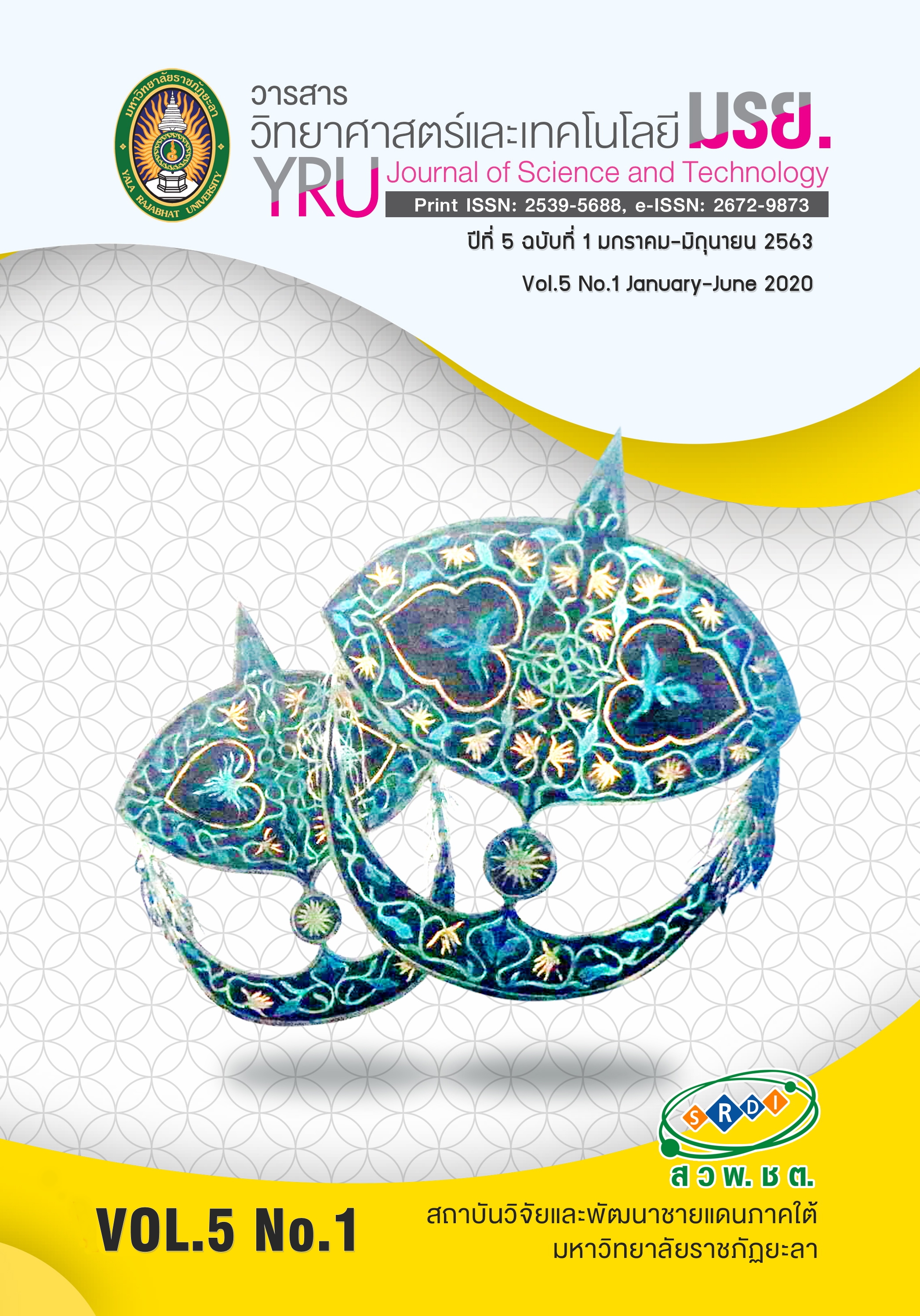การเตรียมสารประกอบ Ni–based oxides โดยวิธีการตกตะกอนร่วมทางเคมี เพื่อนำไปประยุกต์ใช้เป็นตัวดูดซับโลหะหนัก
Main Article Content
บทคัดย่อ
การปนเปื้อนโลหะหนักในน้ำยังคงเป็นปัญหาสำคัญของประเทศไทย จึงทำการวิจัยเพื่อศึกษาการเตรียมสารประกอบ Ni–based oxides ของ NiO, LaNiO3 และ NiAl2O4 โดยวิธีการตกตะกอนร่วมทางเคมี เพื่อนำไปประยุกต์ใช้เป็นตัวดูดซับโลหะหนัก ทำการวิเคราะห์สมบัติกายภาพของผลิตภัณฑ์ทั้งหมด ด้วยเทคนิค X-ray diffraction (XRD), Energy dispersive x-ray spectrometry (EDS), Scanning electron microscopy (SEM), Brunauer– Emmett–Teller (BET) surface area และ Thermogravimetric Analysis (TGA) โดย XRD ยืนยันสารที่เตรียมได้เป็น Ni–based oxides แบบทั่วไป (NiO) เพอรอพสไกต์ (LaNiO3) และสปิเนล (NiAl2O4) และจาก SEM พบว่า สารประกอบทั้งหมดนี้มีพื้นผิวที่มีรูพรุนและมีขนาดอนุภาค 150-400 นาโนเมตร จากผลการวิเคราะห์ด้วยเทคนิค BET พบว่า NiO มีพื้นที่ผิวสูงที่สุด (77.7864 ตารางเมตร/กรัม) เมื่อนำ NiO ไปประยุกต์ใช้เป็นตัวดูดซับโลหะหนักตะกั่วและแมงกานีส พบว่ามีร้อยละการดูดซับตะกั่วและแมงกานีสเท่ากับ 99.55 และ 76.59 ตามลำดับโดยมีรูปแบบของไอโซเทอมของการดูดซับเป็นแบบแลงเมียร์ และน่าจะได้รับความสนใจนำไปประยุกต์ใช้เป็นตัวดูดซับโลหะหนักในการบำบัดน้ำเสียต่อไป
Article Details
บทความ ข้อมูล เนื้อหา รูปภาพ ฯลฯ ที่ได้รับการเผยแพร่ในวารสารวิทยาศาสตร์และเทคโนโลยี มรย. นี้ ถือเป็นลิขสิทธิ์ของวารสารวิทยาศาสตร์และเทคโนโลยี มรย. หากบุคคลหรือหน่วยงานใดต้องการนำทั้งหมดหรือส่วนหนึ่งส่วนใดไปเผยแพร่ต่อหรือกระทำการใดๆ จะต้องได้รับอนุญาตเป็นลายลักษณ์อักษรจากวารสารวิทยาศาสตร์และเทคโนโลยี มรย. ก่อนเท่านั้น
เอกสารอ้างอิง
Aghayan, M. & Hussainova, I. (2015). Fabrication of NiO/NiAl2O4 Nanofibers by Combustion Method. Key Engineering Materials, 674, 31 – 34.
Anchieta, C.G., Tochetto, L., Madalosso, H.B., Sulkovski, R.D., Serpa, C., Mazutti, M.A., Almeida, A.R.F., Gundel, A. & Foletto, E.L. (2015). Effect of thermal treatment on the synthesis of NiAl2O4 spinel oxide using chitosan as precursor. Ceramica, 61, 477 – 481.
Abdel-Shafy, H. I. (2015). Chemical treatment for removal of heavy metals from industrial wastewater. Egyptian Journal of Chemistry, 58, 1 – 12.
Bakalar, T., Bugel, M. & Gajdosova, L. (2009). Heavy metal removal using reverse osmosis.Acta Montanistica Slovaca. 14, 250 – 253.
Dana, E. (2017). Adsorption of heavy metals on functionalized-mesoporous silica: A review. Microporous
and Mesoporous Material, 247, 145 – 157.
Esmaeili, H. & Fououtan, R. (2015). Investigation into ion exchange and adsorption methods for removing heavy metals from aqueous solutions. International Journal of Biology, Pharmacy and Allied Sciences, 4 (12), 620 – 629.
Franco, F., Benítez-Guerrero, M., Gonzalez-Trivino, I., Perez-Recuerda, R., Assiego, C., Cifuentes-Melchor, J. et al. (2016). Low-cost aluminum and iron oxides supported on dioctahedral and trioctahedral smectites: A comparative study of the effectiveness on the heavy metal adsorption from water. Applied Clay Science, 119, 321 – 332.
Haron, W., Wisitsoraat, A., Sirimahachai, U. & Wongnawa, S. (2018). A simple synthesis and characterization of LaMO3 (M=Al, Co, Fe, Gd) perovskites via chemical co-precipitate method. Songklanakarin Journal of Science and Technology, 40 (3), 484 – 491.
Loubuthee, A., Hasin, P. & Koonseang, N. (2007). NiAl2O4 spinel prepared from nickel-aluminium complexes by using various nickel(II) salts via one pot process. Journal of Research in Engineering and Technology, 4, 303 – 314.
Lin, S., Lian, C., Xua, M., Zhanga, W., Liua, L. & Lin, K. (2017). Study on competitive adsorption mechanism among oxyacid-type heavy metals in co-existing system: Removal of aqueous As(V), Cr (III) and As (III) using magnetic iron oxide nanoparticles (MIONPs) as adsorbents. Applied Surface Science, 422, 675 – 681.
Mahmoud, A.M., Ibrahim, F.A., Seham, A.,Shaban, S.A. & Youssef, N.A.(2015). Adsorption of heavy metal ion from aqueous solution by nickel oxide nano catalyst prepared by different methods. Journal of Petroleum, 24, 27 – 35.
Phalathip. P. (2016). The adsorption of heavy metal using modified synthetic fiber. Master’s Thesis. Suranaree University of Technology. (in Thai)
Phaphromphuek, P. (2016). Adsorption and Waste Water Treatment. MSU research digest, 3, 51 – 57. (in Thai).
Peng, G. & Tian, G. (2010). Using electrode electrolytes to enhance electrokinetic removal of heavy metalsfrom electroplating sludge. Chemical Engineering Journal, 165, 388 – 394.
Peng, W., Li, H., Liu, Y. & Song, S. (2016). A review on heavy metal ions adsorption from water by graphene oxide and its composites. Journal of Molecular Liquids, 230, 496 – 504.
Perin, G., Fabro, J., Guiotto, M., Xin, Q., Natilea, M.M..Cool, P., et al. (2017). Cu@LaNiO3 based nanocomposites in TWC applications. Applied Catalysis B: Environmental, 209, 214 – 227.
Pollution control department. (2017). Report of Thailand’s Pollution Situation in 2017 (1st ed.). Bangkok. Ministry of Natural Resources and Environment. (in Thai).
Rath, S.S., Singh, S., Rao, D.S., Nayak, B.B. & Mishra, B.K. (2017). Adsorption of heavy metals on a complex Al-Si-O bearing mineral system: Insights from theory and experiments. Separation and Purification Technology, 186, 28 – 38.
Senkao, Y. (2013). Removal of cadmium (II) and lead (II) ions from wastewater by tamarind and pomegranate shell. Journal of Science and Technology, 2, 184 – 201. (in Thai).
Thabuot, M. (2010). Development of heavy metal and dye adsorbents to substitute for the commercial activated carbon. Naresuan University Journal, 18(2), 17 – 27. (in Thai).
Thansettakij. (2016). The Kingdom of Saudi Arabia’ s fund for the factory – tourism increasing – positive signal in 3 southern border provinces, Thailand [Online]. Retrived June 10, 2018, from : http://www.thansettakij.com/content/28920 (in Thai).


